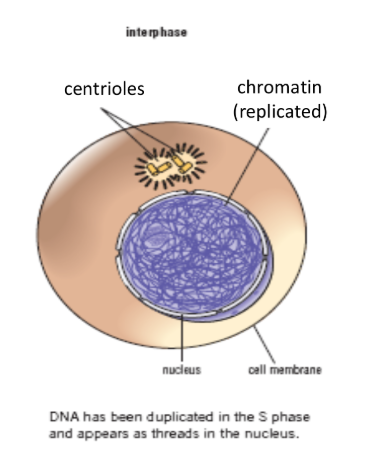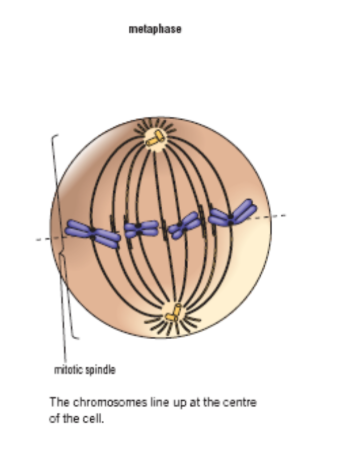Gr.10 Bio (Mitosis)
1/20
There's no tags or description
Looks like no tags are added yet.
Name | Mastery | Learn | Test | Matching | Spaced |
|---|
No study sessions yet.
21 Terms
Cell cycle
Life of a cell including cell growth, DNA replication, preparation for mitosis and meiosis.
Mitosis
Phase of cell cycle in which the cell divides the nucleus material and genetic material.
Chromatin
DNA + proteins
Chromosomes
Condensed DNA which appear in mitosis
Humans have 46 chromosomes - 23 homologous pairs
Karyotype
Organized profile of a person’s chromosomes that are arranged and numbered by side from largest to smallest.
Sister chromatids
Identical copies of a chromosome joined by a centromere.
SA:V
Cells divide instead of growing larger to maintain a higher SA:V ratio.
Smaller cells have a larger SA:V ratio
Allows a cell to exchange materials across the cell membrane more efficiently.
When simplifying the ratio, the volume always has to be 1.
Interphase
Cell grows during interphase.
Can only grow to a certain size because the SA of the cell is too small for the volume
First Growth Phase(G1): cell produces new proteins and organelles
Synthesis Phase(S): DNA and centrioles are replicated in preparation of mitosis.
Second Growth Phase(G2): cell produces organelles and structures needed for cell division.

Mitosis - Prophase
Definition: the phase of mitosis in which sister chromatids condense and the chromosomes become visible
Chromatin condenses into chromosomes
Nuclear membrane begins to break down and the nucleolus disappears.
2 chromosomes called centrosomes head toward opposite ends of the cell.
Extending from the centrosomes, thread-like tubules(part of the cytoskeleton) begin to form spindle fibres.
Centrioles begin to move to opposite ends/poles of cells

Mitosis - Metaphase
Definition: the phase of mitosis in which the chromosomes are aligned across the center of the cell.
Centrosomes reach the opposite ends of the cell
Chromosomes move toward the middle of the cell and line up along the center of the cell
The spindle fibers stretch all the way from the centrosomes to the centromeres
Each centrosome becomes attached to 2 spindle fibers one from each end of the cell.
Note: longest phase in mitosis.

Mitosis - Anaphase
Definition: the phase of mitosis in which the centromere splits apart and the chromatids are pulled to opposite sides of the cell by the spindle fibres.
The protein holding the 2 chromatids together together at the centromere break apart.
The spindle fibres retract, each pulling a chromatid toward one end of the cell.
Once each chromatid separates, each becomes a chromosome in its own right.
Note: one of the shortest phases

Mitosis - Telophase
Definition: the phase of mitosis in which two daughter nuclei are formed
Chromosomes are at opposite poles of the cell
Spindle fibres disappear
Nuclear envelope/membrane forms around the separate sets of chromosomes
Within each nucleus a nucleolus appears
Chromosomes lose their distinct shape to become chromatin again.

Cytokinesis
Cytokinesis: splitting of the cell’s cytoplasm and organelles.
Animal cell: cleavage furrow forms, which pinches in the middle of the cell to form 2 cells
A ring of specialized proteins around the middle of the cell starts to contract which pinches the cell membrane.
Plant cell: The Golgi body produces small vesicles which carries the materials needed to form a new cell wall. The vesicles line up between the two new nuclei forming a cell plate. The cell plate grows outward and joins the old cell wall. New cell walls are secreted on each side of the cell plate, dividing the cytoplasm into two. Then new cell membranes form inside the cell walls, and the division is complete.
Necrosis
Cells dying due to external factors.
Apoptosis
The controlled death of old cells.
Cancer
Genetic mutations that cause cells to undergo abnormal cell division.
Instead of apoptosis, these cells divide uncontrollably.
Cell division occurs so fast that cells pile up on top of one another, forming a tumor.
Changes to the abnormal cells in the tumor can create cancer.
Invades/destroys neighboring cells.
Stimulates other cells to start replicating uncontrollably, spreading cancer and causing diff. types of cancer.
G0
State in the cell cycle where cells are not actively involved in cell division.
It’s a resting phase where cells perform their normal functions
Some cells enter G0 temporarily while others remain in it permanently
Necrosis
Cells may die due to external factors
Eg. toxins, infections, trauma
Apoptosis
Controlled death of old cells
Eg. white blood cells divide to fight viral infection, cells undergo programmed suicide when they are no longer required
Cancer
Cancer is a disease where cells grow and divide uncontrollably.
Cancer cells are undifferentiated - meaning they don’t have a specific job/function.
How they develop:
Genetic mutations cause cells to undergo abnormal cell division —> cells divide uncontrollably instead of apoptosis.
Cell division occurs so fast that cells pile on top of each other forming a tumor —> changes to these abnormal cells in the tumor can create cancer.
How it can be treated:
Surgery (if slow/growing in one place)
Radiation(if fast/invading neraby tissue)
Chemotherapy(if everywhere)
Radiation/chemotherapy: physically shreds the cell’s DNA/disrupts the copying machinery. The more frequently the cell divides, the more likely the drug will kill it.
Binary Fission
Method of asexual reproduction used by prokaryotes, where a single cell divides into 2 genetically identical daughter cells.
DNA replication
Segregation(DNA moves to opposite ends of cell)
Cell division/cytokinesis